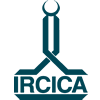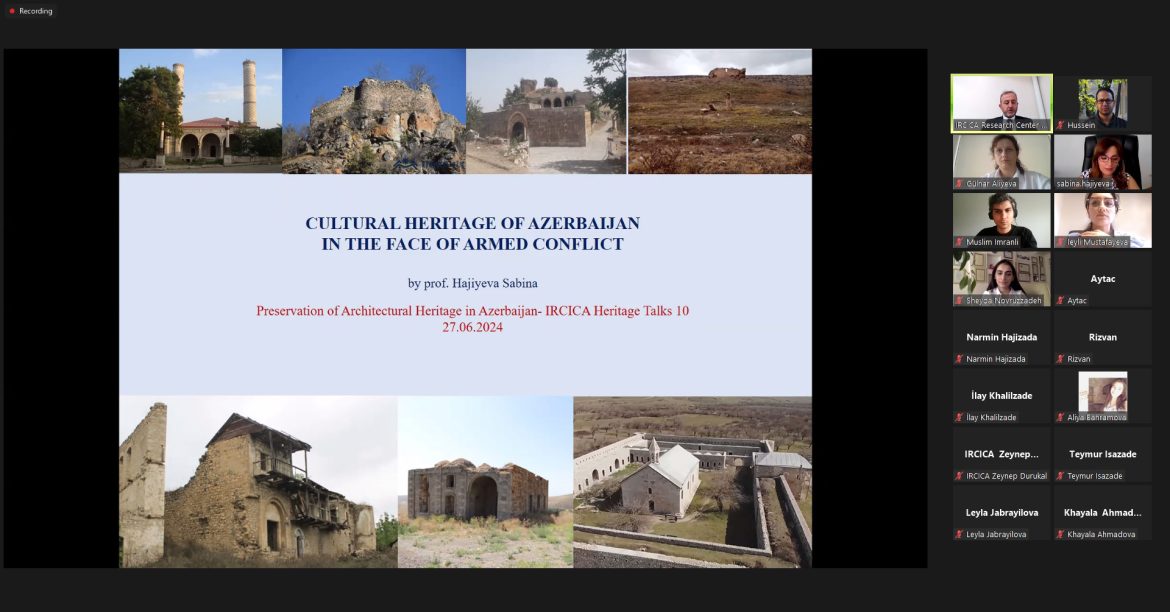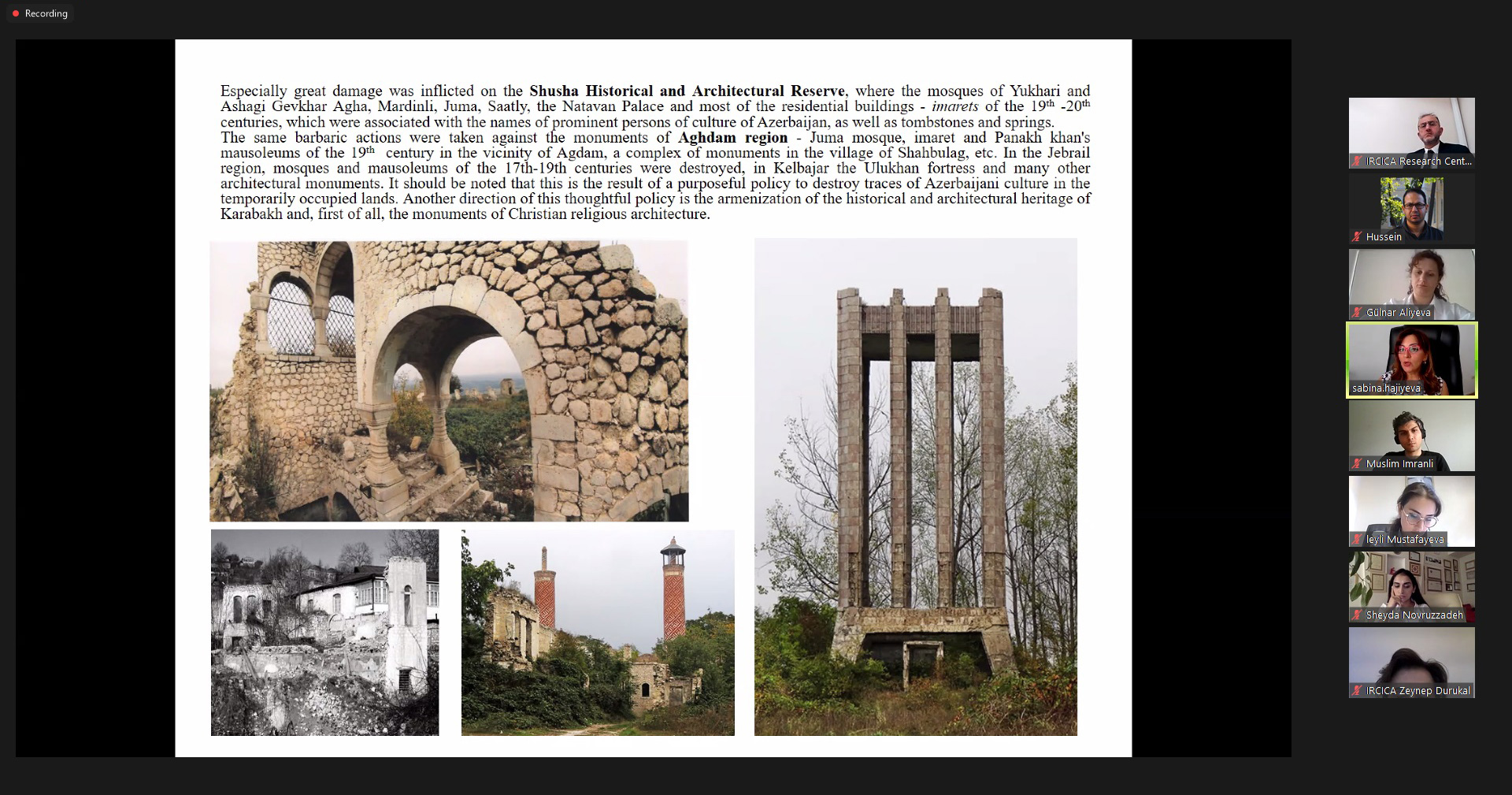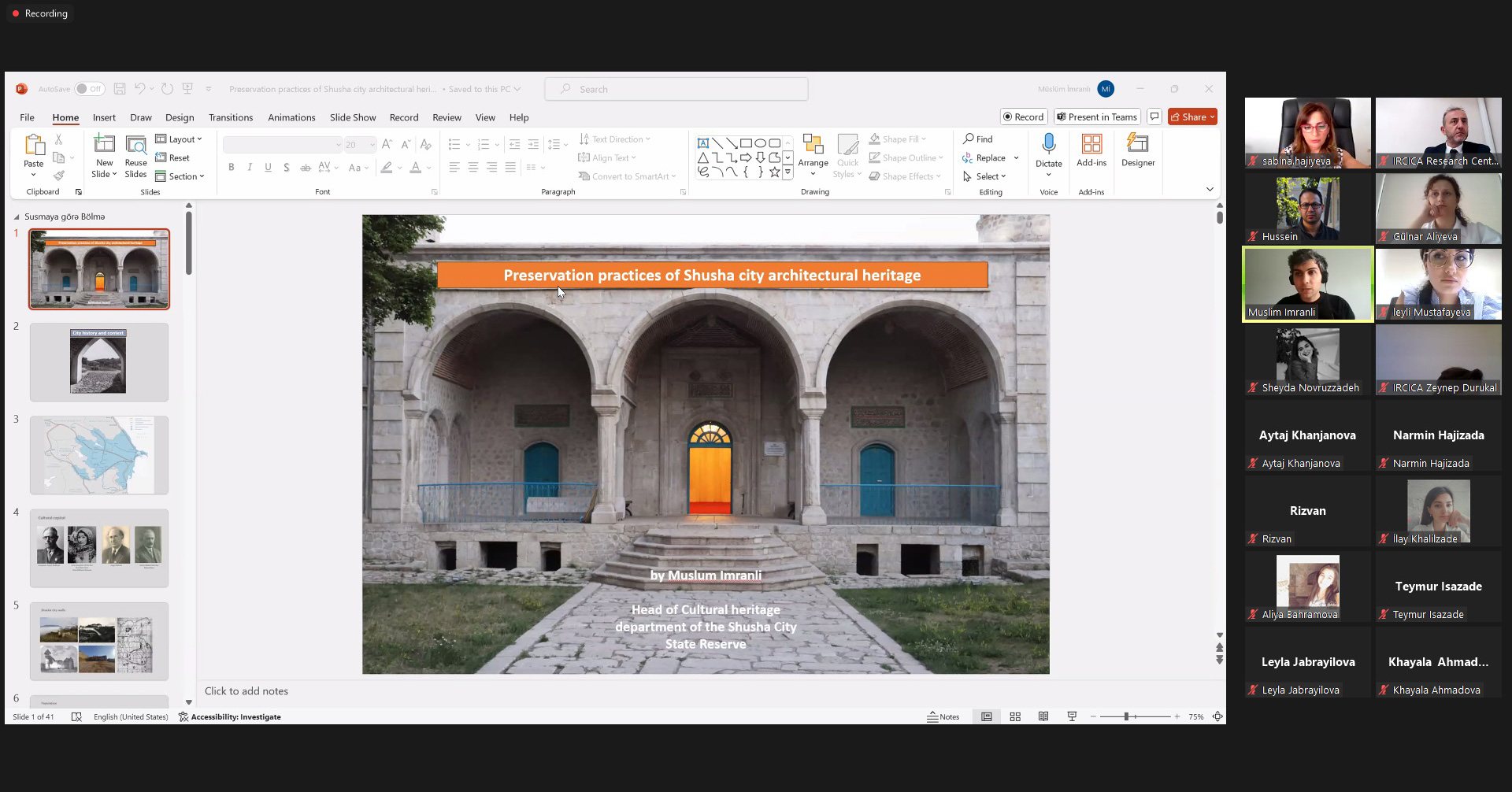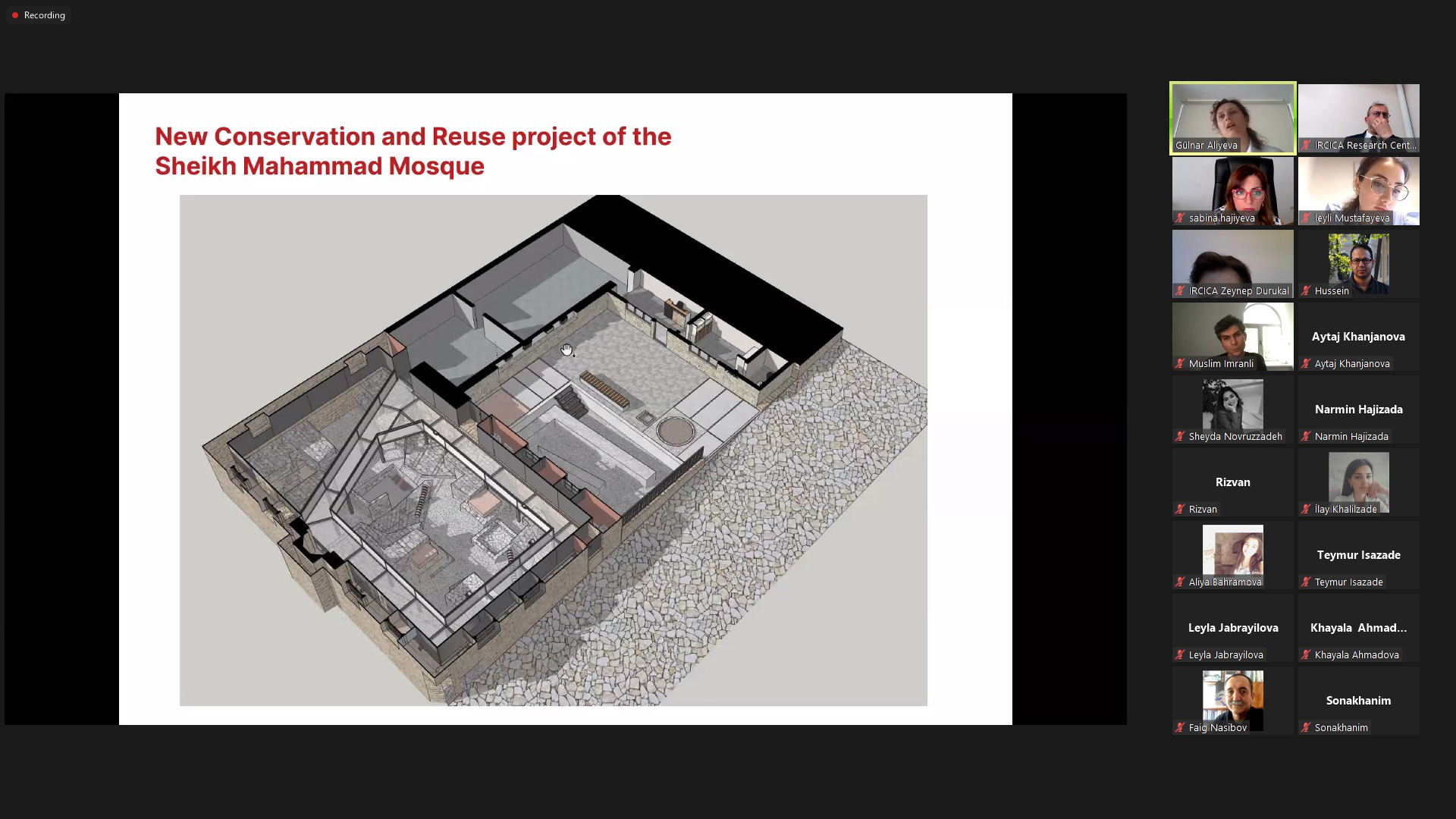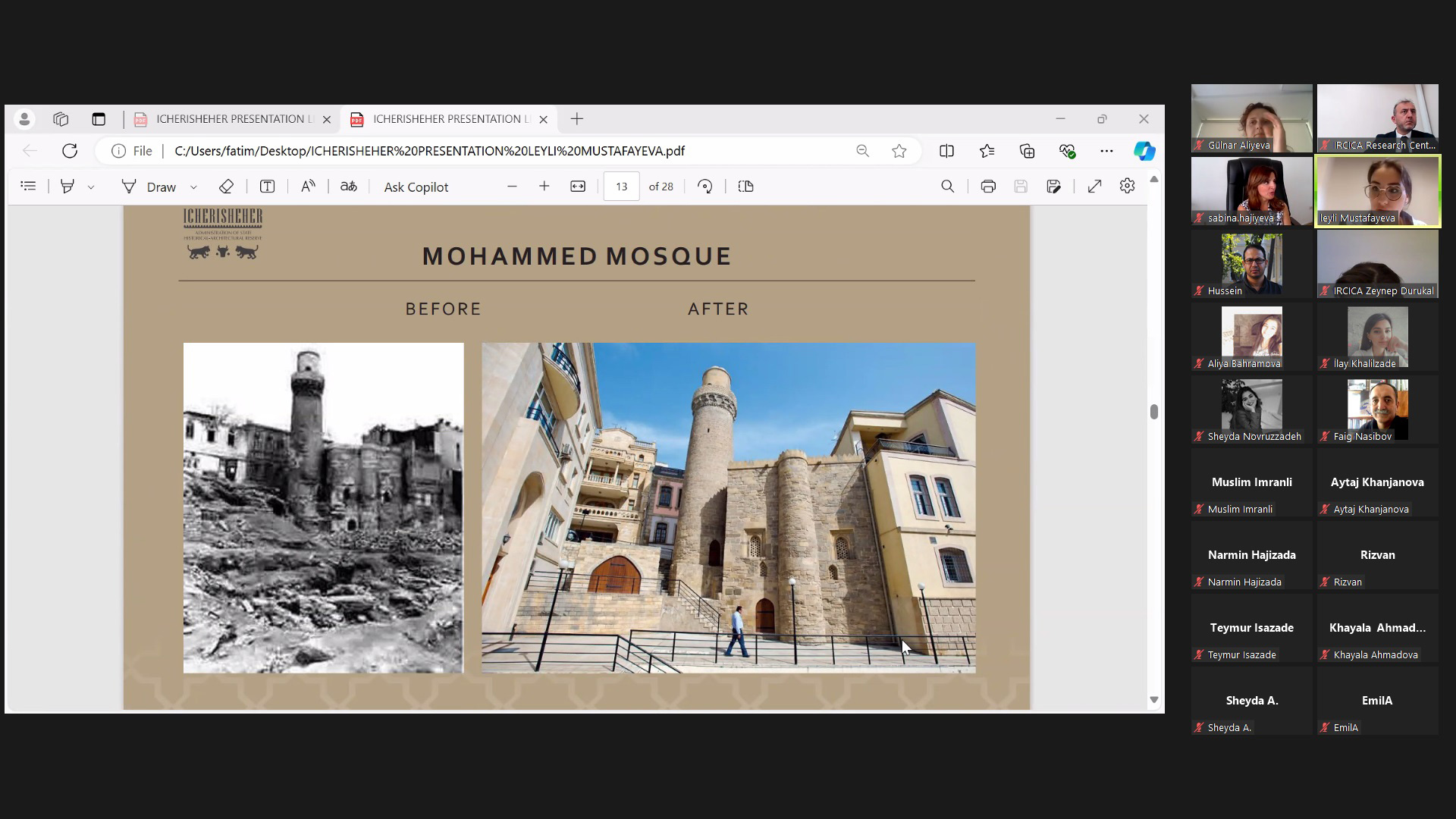In the series of “IRCICA Heritage Talks” an online panel on “Preservation of Architectural Heritage in Azerbaijan” was organized by IRCICA in cooperation with the Union of Architects of Azerbaijan, on 27 June 2024. The panel was addressed by four speakers: Dr. Sabina Hajiyeva, Head of the State Service for the Protection, Development and Restoration of Cultural Heritage under the Ministry of Culture of the Republic of Azerbaijan; Arch. Muslum Imranli, Head of the Cultural Heritage Department of the Shusha City State Reserve; Arch. Gulnar Aliyeva, Head of the Architecture Department at the Reserve Management Center of the State Tourism Agency; Arch. Leyli Mustafayeva, Lead Architect at the Administration of the State Historical-Architectural Reserve “Icherisheher”.
In his opening remarks, Dr. Alidost Ertuğrul, Chief of the Architectural Heritage Section of IRCICA, expressed his thanks to the Union of Architects of Azerbaijan for their collaboration in organizing the joint panel to cover the situation of restoration and preservation of architectural heritage in Azerbaijan. On behalf of the Union of Architects of Azerbaijan, Dr. Sheyda Novruzzade gave opening remarks, underlining the importance accorded given by the Republic of Azerbaijan to rebuilding, restoring and rehabilitating its cultural and architectural heritage, which is the national legacy to be preserved and transmitted and also part of world heritage.
The first speaker, Dr. Sabina Hajiyeva, gave a talk titled “Cultural Heritage of Azerbaijan in the Face of Armed Conflict”. She said that as known, in 2020 Azerbaijan liberated its internationally recognized territories that were under occupation almost for 30 years; after the 44 days liberation war, the conflict left behind, a period of great change started, with the restoration of heritage, development and prosperity. Destruction of monuments during conflicts results in the loss of not only those monuments but also of part of history and cultural identity. Karabagh region that was under occupation is very rich in cultural and architectural heritage dating from thousands of years; the lecturer gave figures about the different categories of heritage assets, including architectural structures, archeological works, gardens and parks, and applied art objects. These assets belong to different faiths and cultures, Hajiyeva recorded that full exploration and assessment of extant and lost monuments have not been completed yet – many territories are still mined. She gave figures of the different types of monuments, where out of 705 monuments examined before and after the occupation, 60 are wiped off the face of the earth, 111 almost completely destroyed, 110 in acute emergency condition, 18 in emergency condition, 173 in satisfactory condition, and only 6 in good condition. Prof. Hajiyeva then presented sample monuments, their state, and restoration efforts, in district of Karabagh, based on abundant illustrations.
Arch. Muslim Imranlı, in his presentation titled “Preservation Practices of Shusha City Architectural Heritage”, said that Shusha and its historical mahallas/districts suffered seriously during the conflict. He introduced Shusha, the region’s “cultural capital”, reviewing its history, architectural features, the typical elements of its traditional structures. Almost all historical buildings are made of local marble stone, with minarets and gates made of brick, but in the present restoration projects, high quality materials are also being used. Many mosques, palaces, public and residential buildings, some associated with the names of prominent personalities of Azerbaijan culture, were destroyed. The speaker gave overviews of the history, monuments, state of preservation, and ongoing restoration projects in different districts; he described the methodologies, materials, sources of information including archives; and also recapitulated the development of administrative processes of restoration.
Architect Gulnar Aliyeva focused on “Sheikh Mohammad Mosque, Baskal, İsmayıllı District from Past to Present”. Sheikh Muhammad Mosque in Baskal. Aliyeva gave the history of the region of İsmayıllı and its Sheikh Mohammad Mosque. Based on detailed plans and photographs, she described the historical layers of architecture in the mosque, the different materials in its composition, its architectural elements and sections, including its public bath, water system, sewage, plane tree age. Aliyeva said she chose to present this Mosque due to its importance as a historical monument and also, beyond this, its archeological properties which were discovered during the restoration process. Therefore, the restoration and re-use of this monument is a hybrid project. This comes to evidence more clearly by situating the monument in its historical, economic and cultural environment, together with its other monuments. Baskal town is located in the north of Azerbaijan, at the foothill of the Caucasus, it traditionally boasts outstanding crafts and traditional techniques of manufacturing, especially silk production, as well as ceramics and metalworks. The speaker said that the Mosque with its various components is a repository of information on Baskal, its craftsmanship, as well as on Islamic scholarship and Sufism and the cultural heritage of the whole region.
Architect Leyli Mustafayeva gave a talk titled “Icherisheher – An Open-Air Museum”. She introduced the State Reserve of Icherisheher in Baku by evoking the different areas and the hundreds of monuments and artifacts included in its scope. She showed pictures and explained the architectural characteristics, design features, architectural skills represented, and cultural influences reflected by each structure. In another part of her talk, Mustafayeva gave information on the objectives, methods and stages of different restoration projects carried out in the reserve. In his closing remarks, thanking the speakers, Dr. Alidost Ertuğrul pointed out that Icherisheher Reserve area is a remarkable compound of conservation projects that stands out because it is at the same time a living urban environment.
At the end of the panel, Arch. Dr. Rizvan Bayramov from Azerbaijan, who assisted IRCICA in organizing this panel, thanked IRCICA and Dr. Ertuğrul for the collaboration extended towards this joint activity. Both sides expressed the wish for continuous cooperation.
